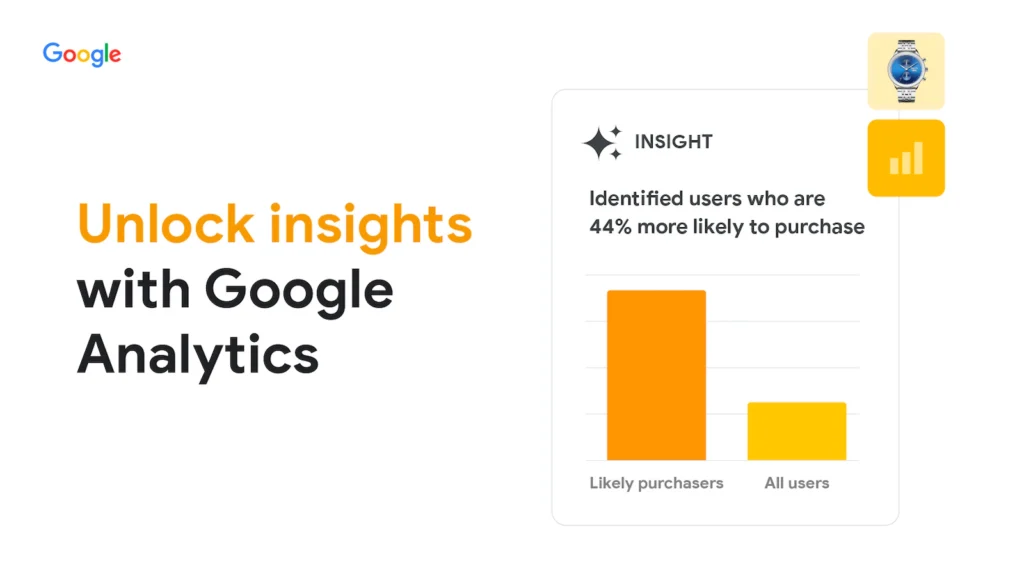Shopify’s native Google & YouTube sales channel isn’t just another integration—it’s the best way to seamlessly connect your Shopify store with Google Analytics 4 (GA4). Designed specifically for Shopify merchants, this native integration delivers accurate, robust ecommerce analytics without the technical headaches. Think of it as the peanut butter to your ecommerce jelly. Let’s dive in and explore why Shopify’s native Google channel is your ideal solution for GA4 implementation.
Why Shopify’s Native GA4 Integration is Your Ecommerce Analytics BFF
GA4 is basically tailor-made for ecommerce, offering an event-driven approach that captures detailed interactions like product views, cart additions, checkouts, and purchases. Shopify’s built-in GA4 integration automatically sends this essential ecommerce data straight to your GA4 property—no coding required, no drama involved.
How to Quickly Set Up GA4 with Shopify’s Google Channel

Step 1: Create Your GA4 Property
First things first, create your GA4 property in your Google Analytics account. Set up a Web Data Stream for your Shopify store and note the Measurement ID (you’ll know it when you see it—it starts with “G-“).
Step 2: Connect GA4 Using Shopify’s Native Channel
Head to your Shopify admin, install the official Google & YouTube sales channel, and connect it to your Google account. Shopify effortlessly configures and deploys all the necessary tags across your store without you having to lift a finger.
Step 3: Verify Data Flow in GA4
Confirm your integration is running smoothly by checking GA4’s Real-Time Reports or DebugView. If you see data streaming, congrats—you nailed it!
Does Shopify’s Native Integration Automatically Track Checkout?
Yes—one of the beautiful things about Shopify’s native GA4 integration is that it automatically tracks your store’s checkout events right out of the box. This includes critical steps like adding payment information, beginning checkout, and completing purchases. There’s no extra setup required on your end, as Shopify’s integration handles it seamlessly. However, if you’re using a customized or third-party checkout solution, additional configuration may be necessary to ensure proper tracking.
The Benefits of Shopify’s Native GA4 Integration
Using Shopify’s native GA4 channel is a no-brainer because:
- Simplicity & Reliability: No coding or tech wizardry required—Shopify handles everything seamlessly.
- Automatic Event Tracking: Critical ecommerce events automatically tracked? Check.
- Fewer Errors: With fewer manual steps, there’s significantly less chance of data discrepancies.
- Built-in Privacy Compliance: Automatically anonymized IP addresses and effortless consent management make staying compliant easier than ignoring a spam call.
Just by following the above instructions you will automatically be tracking the following events:
page_view. A customer visited a page on your online storesearch. A customer searched for a product on your online storeview_item. A customer viewed a product on your online storeadd_to_cart. A customer added a product to their cartbegin_checkout. A customer started the checkout processadd_payment_info. A customer successfully entered payment informationpurchase. A customer completed their checkout
However, certain events like view_cart or remove_from_cart aren’t tracked by default. To include these, you’ll need custom implementation or Google Tag Manager (GTM).
Enhanced Measurement & Conversion Tracking
Activate Enhanced Measurement in GA4 to track interactions like scrolling, outbound clicks, and video engagement automatically. Additionally, mark meaningful ecommerce events as conversions (like purchase or begin_checkout) to enhance your insights.

But Wait, Isn’t Google Tag Manager (GTM) The Most Common Approach?
Traditionally, yes. Google Tag Manager is the Swiss Army knife of analytics—great for extensive customization and advanced setups. If you need ultra-specific tracking or multiple pixel integrations, GTM has got your back. But when it comes to Shopify, interestingly, GTM is simply not the “go-to” approach. Here’s why:
- Unnecessary Work: All the ecommerce tracking that you’d be setting up basically comes “for free” with the Google app.
- Risk of Data Issues: Since Shopify feeds data directly to Google through the channel, it is much more likely to be accurate.
- Increased Maintenance: GTM requires regular oversight and updates.
- Technical Expertise Required: More manual setup means more room for error.
Given the pros and cons, Shopify’s native integration usually emerges as the smarter, hassle-free option for most merchants.
Combining Shopify’s Native Integration with Google Tag Manager (GTM)
It’s worth noting that despite the Google channel being the best practice for integration of GA4, Shopify’s native Google channel and GTM aren’t mutually exclusive—you can (and often should) use both. While the native channel excels at capturing core ecommerce events effortlessly, GTM remains invaluable for handling other marketing pixels, custom events, and non-ecommerce tags like those used for social media tracking and email marketing. The best practice here is to allow Shopify to manage your primary ecommerce analytics through its native channel and deploy GTM separately for all your advanced, non-ecommerce tracking needs. This way, you get accuracy and simplicity where it counts, plus GTM’s flexibility everywhere else.
Navigating Common GA4 Integration Challenges
Even smooth integrations hit the occasional bump. Typically, missing data in GA4 is due to misconfigured Measurement IDs or accidental conflicts. Luckily, Shopify’s simplified integration dramatically reduces these issues, making troubleshooting quick and easy.
Wrapping It Up: Shopify & GA4—Simply the Best Choice
When integrating GA4 with Shopify, the native Google channel clearly stands out as the optimal, hassle-free solution. Easy setup, reliable tracking, robust privacy compliance, and comprehensive ecommerce insights make it a no-brainer. So, relax—your Shopify analytics just got easier.



